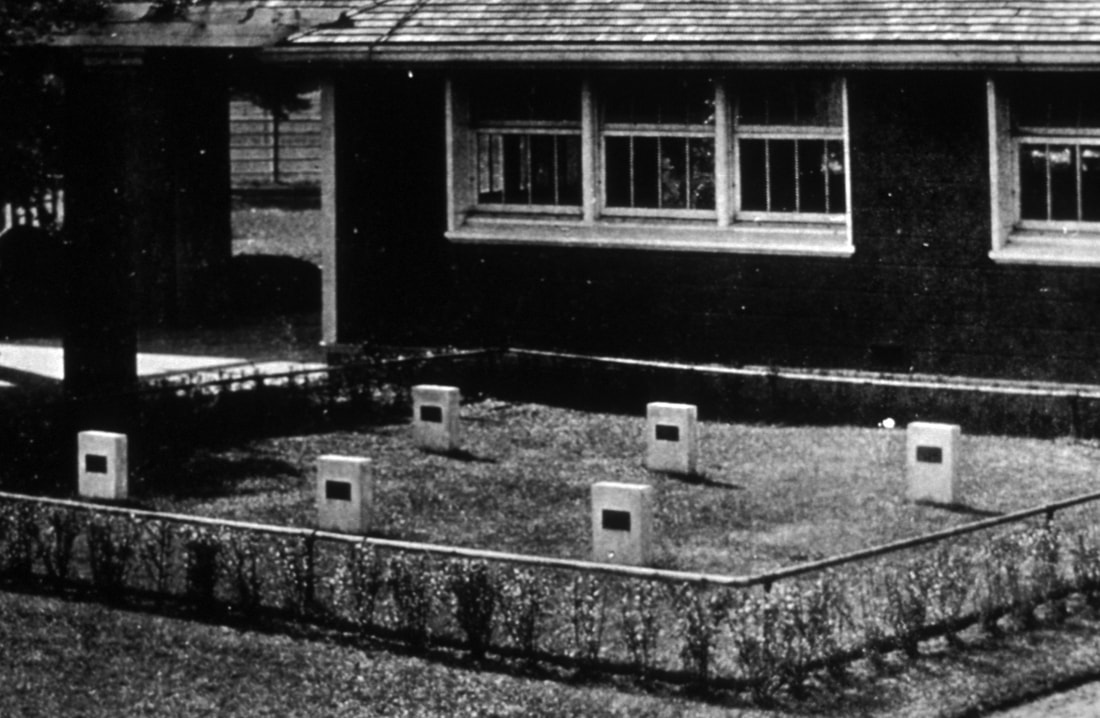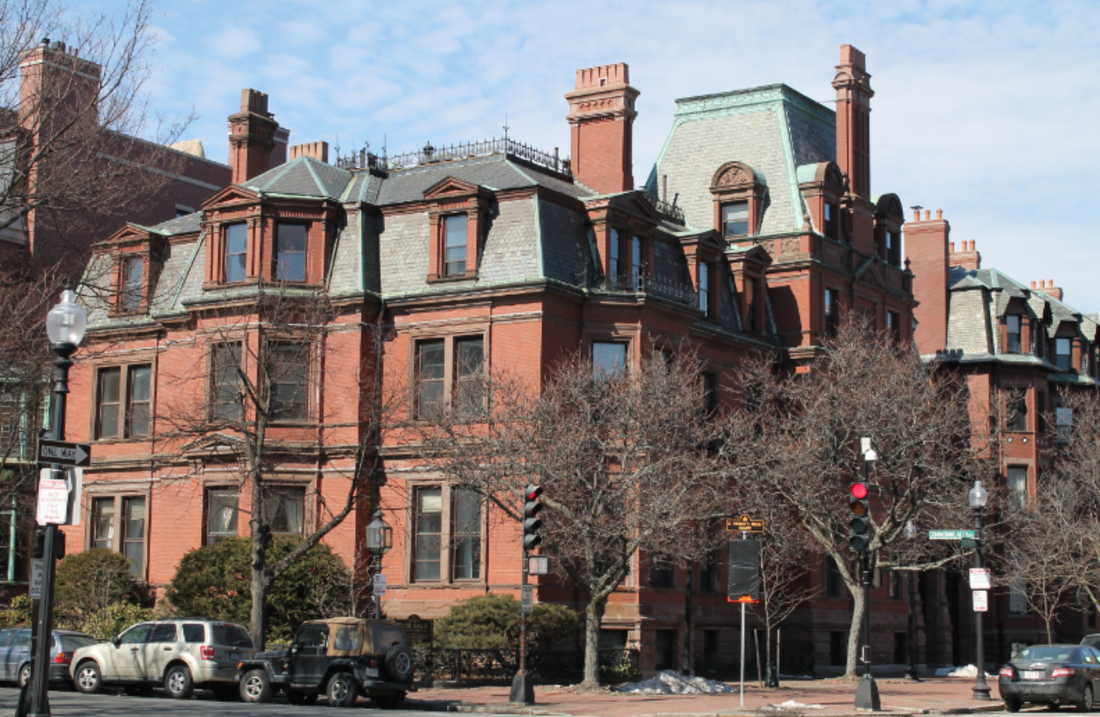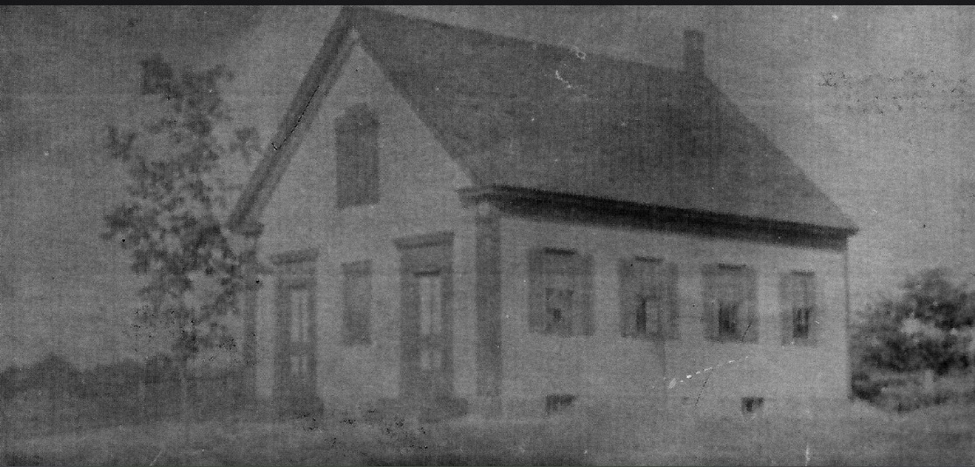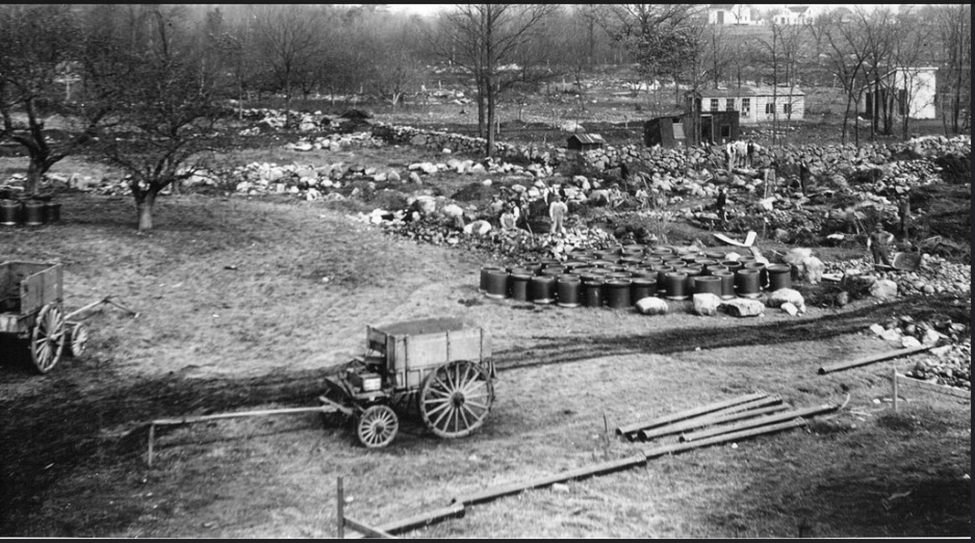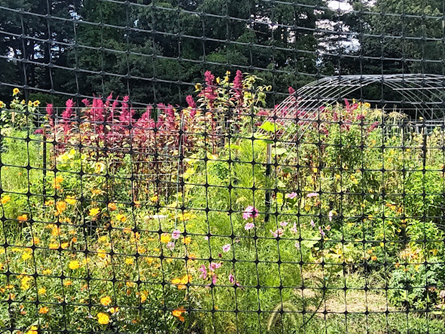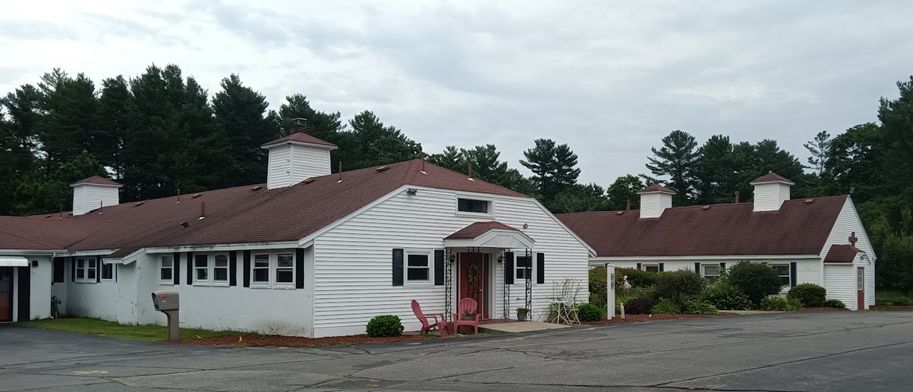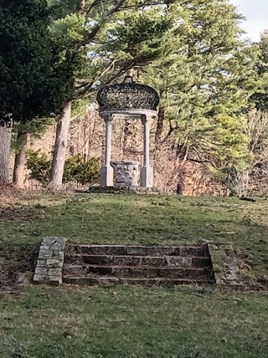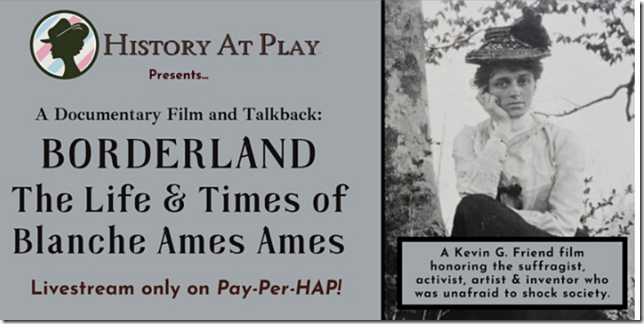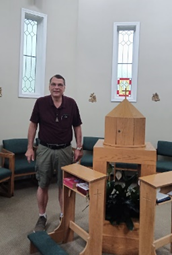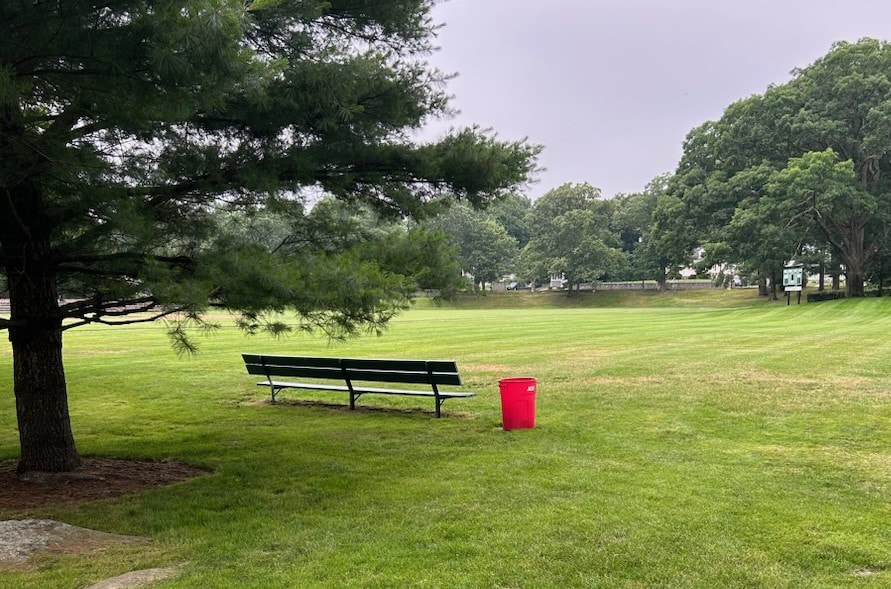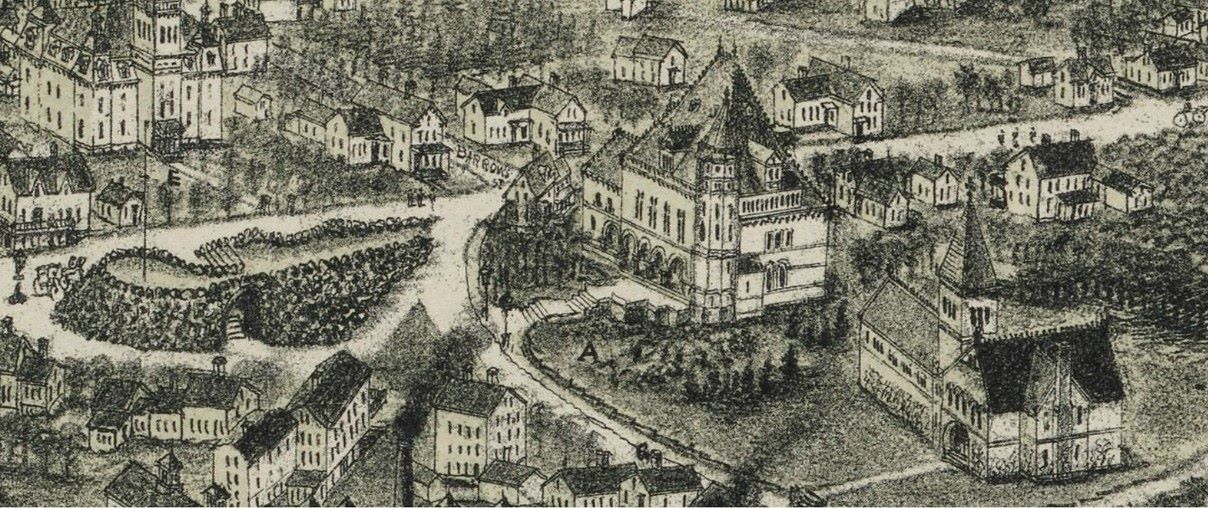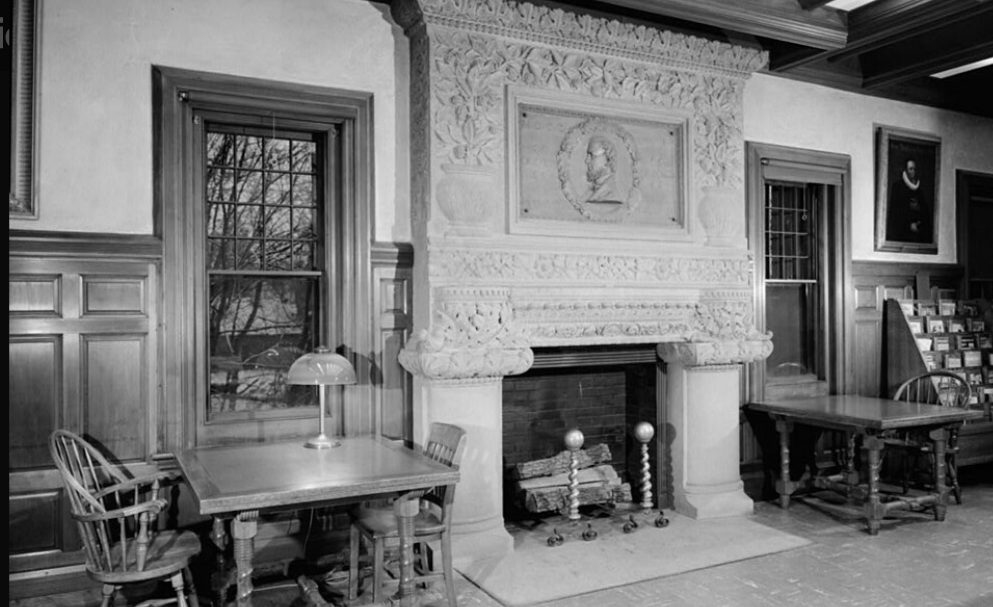|
This is a cemetery, yes, but an unusual one; this is a photo of a bull cemetery located on the Holy Cross grounds near Stonehill College. This graveyard for Frederick Lothrop Ames Jr.’s prized bulls was located somewhere near the barn, which has since been converted, but the tombstones disappeared, and no one knows where they went. According to Reverend Anthony V. Szakaly, C.S.C., when work was being done on an irrigation system some years ago, a large bull bone “popped up”. Today it is displayed in the College archives. Photograph of Bull Cemetery. Courtesy of Stonehill College Archives. Six of the best bulls were buried here. Langwater Guernsey’s were genetically superior and from the 1920's until the 1960's the Langwater cow was considered the perfect cow. Stonehill College was founded in 1948 by the Congregation of the Holy Cross. It is located on what was once the estate of Frederick Lothrop Ames Jr. Today Holy Cross priests and brothers live on the part of the Stonehouse Hill estate where Frederick Ames housed his prized Guernsey cows. Fr. Tony gave me a tour of the lovely grounds here, where past and present meet. Frederick Ames’s cow barn is now living accommodation for the priests and brothers. He took me up to the attic where the charred beams from a fire in the late 1920’s can still be seen. Fortunately, the barn was mostly spared. Above, renovated cow barn, now housing for priests and brothers. Charring in the attic from a fire in the ‘20’s. A view of the old farm silo that now houses a chapel. The silo is on the left and obscured by trees. A better view of the silo. Today, the building that originally housed the old Ames Airport Office and Farm Office serves as a residence for priests. According to Fr. Tony, their closet is the old walk-in safe. As for the Retreat House itself, “The Holy Cross Retreat House is made up of the old cow stalls and the bull pen with later additions made of surplus World War II army barracks. The chapel of the retreat house was once the old hayloft for the cows.” (Fr.Tony) The Holy Cross Retreat House from the outside. It was once a barn for cows and bulls. Inside the Holy Cross Retreat house it is possible to imagine the old cow stalls. The footprint is the same. The stalls have been converted into rooms for those on retreat. A view of the chapel in the hayloft.
There is much more to be said about the history of the Ames farm and the repurposing of the estate, but space is limited. At one time, this particular piece of land was home to a thriving farm known for its Guernsey cattle and Clydesdale horses (Clock Farm). Also- it was the site of an early airfield. I know that somewhere in the ground- though not exactly sure where- strong Guernsey bones still linger, reminders of times past, lush green fields, and fresh raw milk.
0 Comments
Update and A Look Back at Summer Days A quick update on the last newsletter. This is a great photo showing the wooden screen and librarian’s desk as they originally looked. They provided a barrier to the stacks and only the librarian could retrieve books. Borrowers would approach the desk and ask for what they wanted. Notice the drapes on either side. This week, a reminiscence by Tom Wooster about summer days in Easton, 1970’s-‘80’s. Enjoy! "Growing up in Easton in the 70’s and 80’s was a great time to be a kid as we had much more freedom than kids nowadays. Planning our day wasn’t done by parents, but by meeting my friends on summer mornings at the bench by Day Street at Frothingham Park. We would meet most summer days and figure out what sports or adventures we wanted to do on that particular day. Most days involved playing baseball or basketball or going to someone’s house to listen to records and eat whatever snacks were in the house. Sometimes we would go on bike rides around town and my favorite was going to Borderland. We would go through the Town Forest and cross Bay Road and down the dirt road to Borderland and ride the trails there and then usually head to the Corner Store to get soda and candy. Some of my favorite candy bars were the Marathon Bar, Rally Bar, and the Waleeco Bar (which was actually produced by the FB Washburn Candy company in Brockton and they are known today for making Ribbon Candy). If I remember correctly candy bars were around $.15 and cans of Coke or Pepsi $.20 and still could get some penny candy as well. Sometimes we would ride to the fire station and get Simpson Spring soda from a machine where they parked the fire trucks. I don’t remember how much they cost, but I’m thinking it was more than Coke or Pepsi or we would have gone there more often Frothingham Park, bench near Day Street gate, today. We would go home for lunch and then get our chores/jobs done in the afternoon. My jobs were picking up any trash on the ground at the park which took about an hour each day for which I was paid $.25 a day, if I remember correctly. I also had jobs mowing lawns once a week and for that I was paid $5.00 by the homeowner and that price never changed over the years. While I was always eager to run to the store to buy junk food my parents made sure I deposited most of it in the bank. I had my account at Easton Co-operative Bank, which then was located at the corner of Center and Main Street, and ironically is my current employer just at a different location. After dinner on most nights I would play croquet or hide and seek with my siblings until either the mosquitoes drove us inside or our parents called us in for the night. As I look back I realize how good I had it growing up in Easton as I had a great group of friends to hang around with and a very loving family with six siblings. We had much more freedom in those days, but we also were responsible and were where we were supposed to be when we were supposed to be there. I hope you enjoyed my short summary of what I remember most about how I spent my summers during my childhood in Easton. Of course growing up with a beautiful park across the street and having six siblings also allowed us to do many things together and for that I will always be grateful to my parents who raised us to enjoy life, but also to be responsible for our own actions." ...playing games in the park til way after dark….back through the crooked bar again, where only children fit. Anne Wooster Drury [email protected] "When all else fails, give up and go to the library." Stephen King North Easton: left to right, Rockery, Oakes Ames Hall, Ames Free Library. Fortunately, in Easton, we have a lovely library with an interesting history. I have enjoyed it throughout my life. I remember sitting on the wooden floor in front of the shelves in the Children’s Wing searching for a mystery I hadn’t read yet. Later, in junior high, I remember working on homework with friends and waiting to be “shushed” if we so much as whispered. (I remember there was a book on human biology or anatomy that had to be requested from the librarian at her desk. We had some giggles about that.) Then in college, snagging a study alcove and hiding in it for hours. Later, I loved venturing upstairs to the balcony area, where the floorboards creaked as you walked, searching for treasure among the books on art and exotic religions. Picture of the Reading Room with its large brownstone fireplace designed by Stanford White, above it a bas relief of Oliver Ames, the library's donor, by Augustus Saint-Gaudens. Here are some interesting facts about the library’s early days, collected from A Centennial History of Ames Free Library of Easton, Inc. 1883-1983 on the Ames Free Library website. The Ames Free Library opened in 1883. Prior to that, there were some subscription libraries in Easton, but this was the first public library, funded by Oliver Ames in his will. *In 1883 when the library opened a borrower had to be over fourteen years old and could only take out one book at a time. *Initially the books were arranged by subject, with 19 departments. Black covers were put on the books to protect them. *When the library opened in March of 1883, 1,643 books went into circulation. At the time, the population of Easton was 4,000. An impressive amount of interest. The first borrowers preferred Prose Fiction (novels) and Juvenile Reading. *For a long time, the book stacks were separated from the rest of the library by a carved wooden screen and the librarian’s desk. Only the librarian could go into the stacks and retrieve your book. *Mary Lavinia Lamphrey, daughter of the Easton High School principal, Maitland C. Lamphrey, became the second librarian in 1891. Although she’d been a student at Boston University, she received only one month training before officially taking over; she and her family moved into the apartment on the second floor of the library. Interestingly, her father was to complete or oversee any janitorial work. She served as librarian for 53 years and was enormously loved and respected. Miss Mary Lavinia Lamphrey. She continued to live in her library apartment even after she retired.
*Because there had been an increase in the Swedish population, in 1905 twenty books in Swedish were acquired along with a subscription to a Swedish newspaper. *Sometimes young boys were sent by Miss Lamphrey directly to the Queset to wash their hands before they were allowed to touch the books. *In 1932 there was a huge change when, “‘the cage’ (Miss Lamprey's high desk) was removed. Also removed was the grill between the charge room and the stack area. The high desk and grill gone, the library moved into the era of the open stack, and readers could go directly to the shelves to pick out their own books instead of filling out ‘Hall Slips.’ The balcony was still off-limits and would be, until Mrs. Irene Smith, Miss Lamprey's successor, opened it in 1944.” Today it is closed and used for storage. Today, as in the past, the Ames Free Library is an island of calm in a busy world and a portal to numerous other worlds. Slip into River Heights with Nancy Drew or walk into the woods of Concord with Henry David Thoreau. The fact that it is within walking distance of schools is a bonus. To quote Mary Lamphrey on the occasion of her 50th year as librarian, "In a library you deal with the stuff out of which eternity is made - the garnered best that mortals have thought and hoped, preserved in words of force and beauty." Anne Wooster Drury [email protected] |
Author
Anne Wooster Drury Archives
June 2024
Categories |
Easton Historical Society and Museum
PO Box 3
80 Mechanic Street
North Easton, MA 02356
Tel: 508-238-7774
[email protected]

